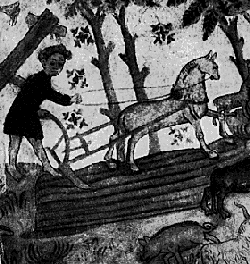Meet the Middle Ages
BackFreeholders

Many peasants owned their farms and paid tax to the king. In Sweden over 50 per cent of the peasants were freeholders, but this could vary in different parts of the country. In sparsely populated Finland, 90 percent of the population were freeholders. In the agricultural districts in Södermanland, Uppland, as well as in Väster- and Östergötland., there was only a small number of freeholders. In many villages, the freeholders and the tenant farmers lived side by side.
In Norway a third of the peasants were freeholders. In Denmark, only a tenth of the peasants owned their land. In most European countries, the nobility and the Church owned most of the land, and the peasants were totally dependent on their landlords.
In Sweden, the peasants were powerful. In the late Middle Ages, the kings needed peasant support to be able to remain on the throne.
The peasants paid a fixed tax which depended on the size of the farm. The tax was paid in money or farm produce such as grain, butter, cheese or meat. On the coasts, the tax was paid in fish, in other regions it could be paid in iron. The tax was given to the Royal Bailiff on special occasions. When there was a war, or if a great event was to take place, for example a wedding or a coronation, the peasants had to pay extra taxes. They also had to dolabour service at the Royal Castle.